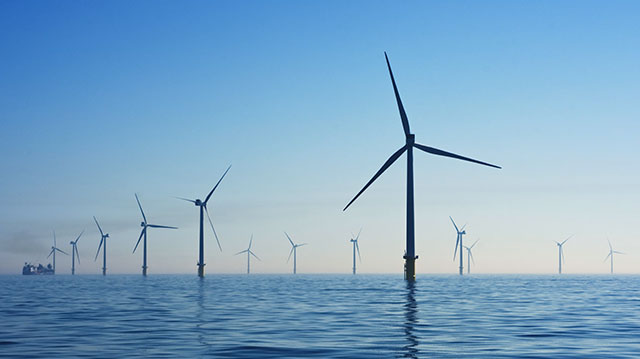
Impact of offshore wind farms on the environment
- Project team:
- Thematic area:
- Topic initiative:
Committee on Education, Research and Technology Assessment
- Analytical approach:
TA project
- Startdate:
2022
- Enddate:
2025
sprungmarken_marker_3513
Background and central aspects of the topic
Power generation at sea is becoming increasingly important in Europe and worldwide. According to estimates by the International Energy Agency (IEA), offshore wind power in Europe could increase its share from the current level of around 2% to around 25% within 20 years and thus become the most important supplier of electricity. In Germany, too, the expansion of offshore wind power is being driven forward, and large offshore wind farms (OWPs) have been and are being built in the North and Baltic Seas. There are now more than 1,500 wind turbines (WTGs) in operation with a total capacity of around 8 gigawatts (GW), which currently contribute around 5% to Germany's gross electricity generation. The proclaimed expansion targets for offshore wind energy are 30 GW for 2030 and at least 70 GW for 2045.
Other countries in the North Sea and Baltic Sea have formulated ambitious expansion targets. For example, at the "North Sea Summit" on May 18, 2022, Belgium, Denmark, Germany and the Netherlands agreed on the goal of installing a combined 65 GW of wind power capacity in the North Sea by 2030 and at least 150 GW by 2050. A rough estimate of the area required illustrates the enormous scale of the expansion: assuming an average power density of 10 MW/km2, wind turbines with a total capacity of 150 GW would cover an ocean area of approximately 15,000 km2 (roughly equivalent to the area of Schleswig-Holstein). The UK also plans to meet over 30% of its electricity needs with wind power from the North Sea by 2030.
In both the North Sea and the Baltic Sea, the vast majority of wind turbine development is taking place in the Exclusive Economic Zone (EEZ) due to the greater sensitivity of the nearshore areas, although the German part of the EEZ in the Baltic Sea is relatively small and is used primarily as a shipping lane. Meanwhile, the conflicting goals between different uses of the marine space (e.g., energy production, shipping, fishing, science, defense, tourism) and its ecological conditions or conservation needs (protection and enhancement of the marine environment and its biological, chemical, and physical processes; preservation of cultural heritage, etc.) are clearly evident. The assessment of the possible impacts of wind turbines (both during construction and operation) on other forms of use and on the marine environment varies considerably, since wind farms, for example, can severely disrupt ecosystems on the one hand, but on the other hand also provide new refuge areas for endangered fish stocks, for example (since no fishing or shipping is usually permitted between the wind turbines for accident prevention reasons).
In general, however, the possible effects of offshore energy production on the environment and on the economy (fisheries, commercial and passenger shipping, etc.) have hardly been researched nationally or internationally to date and presumably depend heavily on factors such as the distance from the coast of the wind farms, water depth, turbine configuration or type of foundation.
Objectives and approach
The aim of the TA project is to address fundamental questions, such as whether and in what way offshore wind farms (OWPs) may interfere with the overall ecological context (in addition to the individual fish, bird and mammal species affected) in the Baltic and North Seas, and what technological options exist or need to be developed in order to achieve sensible adjustments to OWPs with the aim of achieving a balanced "compromise" between environmental protection, fisheries and energy generation.
Based on the political expansion targets for offshore wind energy production, current area development plans for the German EEZ as well as comparable documents from other incentive states, a comprehensive overview of the status and perspectives of wind energy expansion in the North Sea and Baltic Sea will first be developed. The environmental protection standards to be observed in the planning, construction and operation of offshore wind farms (e.g. international agreements on the prevention of adverse effects on the marine environment, EU directives on environmental and fisheries policy, national regulations in the riparian states such as obligations to carry out environmental impact assessments) will be presented and their effects discussed. Furthermore, different technological options for offshore wind energy generation (e.g. different foundation types) as well as the further infrastructure development necessary for the maintenance of the WTs as well as for the transport of the wind energy from the sea to the land will be considered and discussed.
Taking into account the existing state of research, the (causes of) possible environmental hazards and impairments (impact factors) and potential impacts on the individual protected goods of the marine environment are to be identified and described for the various technology options. Protected goods to be considered, if applicable, would be fish species/fish stocks, species of the seabed area/benthos, marine mammals, species of resting, breeding and migratory birds, sediment, water quality, stratification, flow and temperature, food and nutrients.
Project progress
As part of the project, two comprehensive expert reports were commissioned: one on the environmental impact of offshore wind farms and their specific effects on marine ecosystems, and the other on the impact of large offshore wind farms on the overall ecology and economy of the North Sea and Baltic Sea regions. Following evaluation of these reports, the final report will be submitted to the new TA reporting group for approval in Q4 2025.
